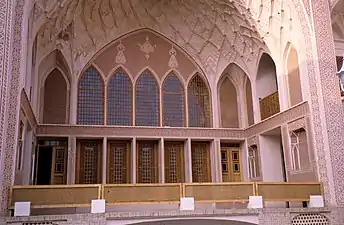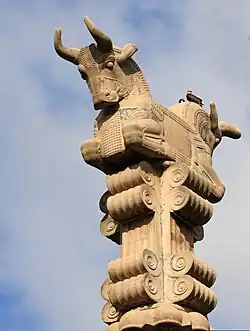A panjdari (Persian: پنجدری) is a traditional element of vernacular Persian architecture.[1]
The word comes from "panj" (پنج five) and "dar" (در window or door), meaning "five windowed room".
By definition, a panjdari is a large room that is often flanked to the main talar of the house, and most often connected to a large balcony, where five large contiguous windows provide primary views to the main courtyard of the house.
In modern terms, the room would be the equivalent of the living room of the house. However, traditional Persian houses were very large and had many rooms. The panjdari was therefore a main daily hub of the inhabitants.
Gallery
 A fine example of a Panj-dari seen from the main balcony of the Amerian House
A fine example of a Panj-dari seen from the main balcony of the Amerian House.jpg.webp)
.JPG.webp)
.JPG.webp)
.jpg.webp)

References
- ↑ Fallāḥʹfar, Saʻīd (سعید فلاحفر). The Dictionary of Iranian Traditional Architectural Terms (Farhang-i vāzhahʹhā-yi miʻmārī-i sunnatī-i Īrān فرهنگ واژههای معماری سنتی ایران). Kamyab Publications (انتشارات کامیاب). Kāvushʹpardāz. 2000, 2010. Tehran. ISBN 978-964-2665-60-0 US Library of Congress LCCN Permalink: http://lccn.loc.gov/2010342544 pp.52
This article is issued from Wikipedia. The text is licensed under Creative Commons - Attribution - Sharealike. Additional terms may apply for the media files.
